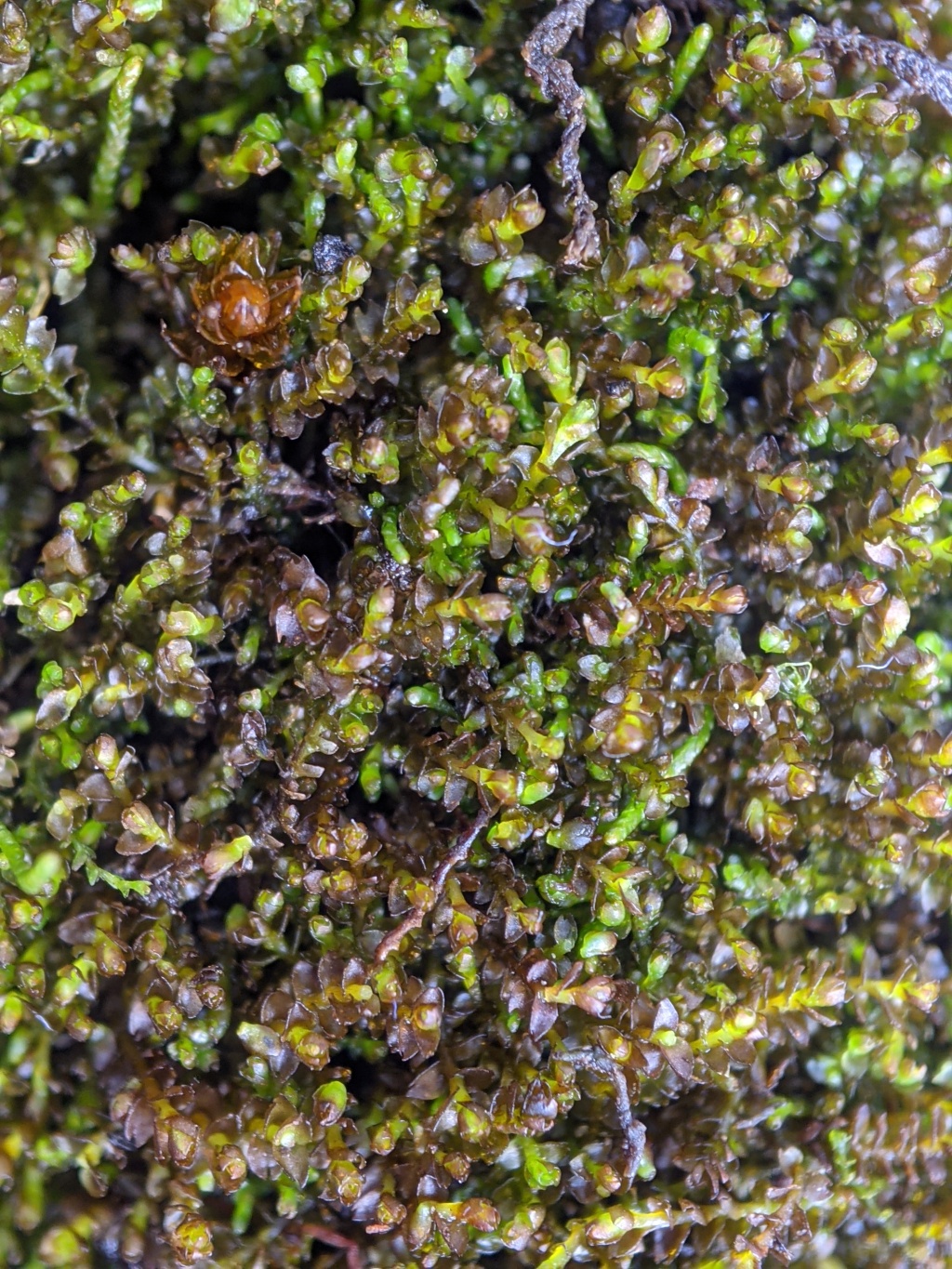Chaetophyllopsidaceae
Mostly terrestrial, rarely lithophytic or on dead logs, dioicous. Asexual reproduction by tetrahedral gemmae produced at shoot apices. Stems sparingly or pinnately branched, with two ranks of lateral leaves and a third rank of underleaves; branches emerging from main stem laterally and with a collar of tissue at base. Lateral leaves obtrapezoidal to reniform in outline, divided to around half its length or slightly more into three main lobes, succubous, alternate, imbricate, becoming larger toward axis apices; main lobes triangular or ovate, strongly crispate, equal or acroscopic lobe smaller, with an additional lobe at the base of the basiscopic and acroscopic lobes and margins of all main lobes often developing several minor lobes, rounded at apex, often abaxially with scattered lamellae, brownish- or grey-green, with numerous hyaline single-celled setae along lobe and lamellae margins. Underleaves subquadrate in outline and narrower than lateral leaves, wider than stem, deeply divided into two main lobes, free from lateral leaves, imbricate, with numerous marginal single-celled setae; lobes fusiform in outline, crispate, each with several smaller lobes, rounded at apex. Leaf cells polygonal, thin-walled, with small concave sided trigones, those forming setae drastically elongated and thick-walled, with (13–) 18–27 oil bodies; oil bodies globose or elliptic, obscurely papillose or becoming botryoidal, hyaline. Rhizoids scattered along abaxial stem, hyaline. Gynoecium terminal on main stem, surrounded by a perianth; perianth oblong-fusiform, weakly trigonous, 4–8-groved at least toward mouth, with a contracted and dentate mouth. Sporophyte unknown.
One species, C. whiteleggei (Carrington & Pearson) R.M.Schust., in New Zealand, south-west western Australia, South Australia, New South Wales, Victoria and Tasmania.
Chaetophyllopsis whiteleggei is a morphologically distinctive liverwort. The highly crispate and lobed leaves with numerous hyaline single-celled setae along the margins that give the shoots an overall furry appearance make this species unmistakable. It has alternatively been placed in the Cephaloziellaceae (Váňa et al. 2013; Söderström et al. 2016). While relationships in the group including Cephaloziellaceae and related genera and families (suborder Cephaloziinae) are far from well-resolved, multiple chloroplast phylogenies have shown Chaetophyllopsis as belonging to a separate lineage to the Cephaloziellaceae (Hendry et al. 2007; Gradstein et al. 2014). Of the genera sampled in molecular phylogenetic analyses, only Anastrophyllopsis (R.M.Schust.) Váňa & L.Söderstr., Andrewsianthus R.M.Schust. and Gottschelia Grolle have been resolved as potential close relatives (Gradstein et al. 2014; Bakalin et al. 2024). Schuster (1960) described the family Chaetophyllopsidaceae to accommodate Chaetophyllopsis and Herzogianthus R.M.Schust. This latter genus is likewise morphologically distinctive, has since been found to be unrelated to Chaetophyllopsis, and is now in its own family (Hendry et al. 2007). Until the phylogenetic position of Chaetophyllopsis and the relationships between Cephaloziellaceae and its related families are better resolved, the isolated phylogenetic position and its morphological distinctiveness are here recognised by retaining Chaetophyllopsis in its own monotypic family.
Bakalin, V.A., Vilnet, A.A., Klimova, K.G., Nguyen, V.S. & Choi, S.S. (2024). Gottschelia (Gottscheliaceae, Marchantiophyta) in Indochina. Plants 13 (16): 2198.
Gradstein, S.R., Laenen, B., Frahm, J.-P., Schwarz, U., Crandall-Stotler, B.J., Engel, J.J., von Konrat, M., Stotler, R.E., Shaw, B. & Shaw, A.J. (2014). On the taxonomic status of the enigmatic Phycolepidoziaceae (Marchantiophyta: Jungermanniales) with description of a new species, Phycolepidozia indica. Taxon 63: 498–508.
Hendry, T.A., Wang, B., Yang, Y., Davis, E.C., Braggins, J.E., Schuster, R.M. & Qiu, Y.-L. (2007). Evaluating phylogenetic positions of four liverworts from New Zealand, Neogrollea notabilis, Jackiella curvata, Goebelobryum unguiculatum and Herzogianthus vaginatus, using three chloroplast genes. The Bryologist 110: 738–751.
Schuster, R.M. (1960). Studies on Hepaticae. II. The new family Chaetophyllopsidaceae. Journal of the Hattori Botanical Laboratory 23: 68–76.
Söderström, L., Hagborg, A., von Konrat, M., Bartholomew-Began, S., Bell, D., Briscoe, L., Brown, E., Cargill, D.C., Costa, D.P., Crandall-Stotler, B.J., Cooper, E.D., Dauphin, G., Engel, J.J., Feldberg, K., Glenny, D., Gradstein, S.R., He, X., Heinrichs, J., Hentschel, J., Ilkiu-Borges, A.L., Katagiri, T., Konstantinova, N.A., Larraín, J., Long, D.G., Nebel, M., Pócs, T., Puche, F., Reiner-Drehwald, E., Renner, M.A.M., Sass-Gyarmati, A., Schäfer-Verwimp, A., Moragues, J.S., Stotler, R.E., Sukkharak, P., Thiers, B.M., Uribe, J., Váňa, J., Villarreal, J.C., Wigginton, M., Zhang, L. & Zhu, R. (2016). World checklist of hornworts and liverworts. Phytokeys 59: 1–828.
Váňa, J., Söderström, L., Hagborg, A. & von Konrat, M. (2013). Notes on early land plants today. 40. Notes on Cephaloziellaceae (Marchantiophyta). Phytotaxa 112: 1–6.
 Spinning
Spinning